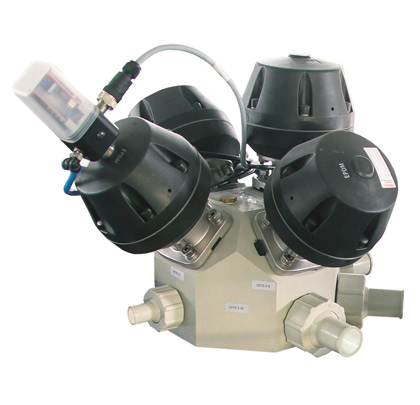As a world leading manufacturer of complex multi-port stainless steel diaphragm valves, GEMÜ has earned an excellent reputation in the biotech and pharmaceuticals’ markets. GEMÜ is now transferring the skills acquired in biotech and pharmaceutical applications, to water applications by designing and manufacturing plastic multi-port block valves.
The space saving compact build, minimizes joint requirements. The simple to install, maintenance friendly nature of the GEMÜ multiport diaphragm valves aid in making multi-port valves an ideal selection for easy installation of a virtually leak-free system in several water applications where space conservation and continuous productivity is essential. Pure water generation systems are one of many systems that can benefit from multi-port diaphragm valves as will be seen in the following.
KEYS TO GENERATING PURE WATER
The generation of pure water involves the established procedure of combining the following three sub-processes: ion exchange, reverse osmosis and electro-deionization. The multiport valve offers its greatest service to the overall process when placed just upstream of the ion exchange process where feed water enters the system. From there multiple ports can be designated to each process allowing for flow diversions to replicate or backup processes that would aid in maintenance while maintaining continuous processing.
When starting the pure water generation process, the initial feed water flow would enter the first multiport valve port just upstream of the ion exchange process when the pneumatic controller switches the diaphragm valve of the inflow port from normally closed to open, allowing new feed water to reach the filters. The controlled flow would then be pushed through the softening filter(s) from top to bottom with the calcium and magnesium ions being replaced by sodium ions producing soft water. The flow, controlled by the pneumatic actuator on the first port, would maintain a constant pressure that would negate the ability of pure water to flow back into the filters. Instead, the pure water is forced up and out of the ion exchange system to the reverse osmosis stage.
THE ROLE OF REVERSE OSMOSIS AND ELECTRO-DEIONIZATION
During reverse osmosis, the softened water is pressurized prior to entry into the system. The pneumatic actuator on the reverse osmosis designated process port can be programmed to retain soft water flow until the required high pressure for reverse osmosis has been reached and can be maintained. The controlled flow is released and forced through the permeators where nearly 98 percent of the sodium and nearly all remaining organic matter is extracted from the water which then moves on to electro-deionization (EDI).
EDI is a residual desalination process that includes a membrane separation process and ion exchange. There are two chambers in which one is filled with a special ion resin that consists of cation and anion permeable membranes that are used to filter the remaining unwanted residual materials, ionogenes, from the water. An electric current is applied to make the ionogene substances mobile in the water and attracted to the charge created by the current. The ions are magnetically drawn toward the charge and can only get through the membrane if it is in accordance with their charge separating the ions from the water which is not in accordance to the charge.
Here a final output diaphragm port would be used to allow the remaining pure water to be retained so that it can be drained into a pure water storage tank and the waste matter can be relocated to a separate container that would be used for disposal. The pneumatic actuator would make the normally closed diaphragm open to allow the mobile ions to be drawn away from the water. When the required purity level is reached, the actuator would allow the diaphragm to close leaving the high purity water and the final waste removed in two separate containers to be drained to their respective destinations.
SAVING SPACE, INCREASING PRODUCTION
As can be seen in this pure water processing overview, the multiport diaphragm valve block groups virtually all of the diaphragm valves into one unit and accommodates multiple flow scenarios including process flow and maintenance all in one place. This unit can be controlled by a series of compact actuators on each port that can receive all of their signals from one directive device allowing the multi-port system to ensure continuous flow saving time and money.
Prior to the development of the multiport diaphragm valve block, the pure water processing system would have been mostly “in-line” requiring a significant foot print for proper assembly and operation. With the multiport system, the foot print can be reduced to less than half by allowing processing phases to be built around one central operation point with less piping materials utilized, fewer vulnerable sealed joints, stack ability and a single point of automation controls. The multi-port diaphragm valve contributes to saving space and allowing the possibility for increased production.
About the Author:
Jared Godfrey is plastics product manager for GEMÜ. The field of applications covered by GEMÜ’s product range starts with control and regulation of heavily contaminated sea, river and brackish water and extends to ultra-pure water production in the semiconductor and pharmaceutical industries. For more information, visit www.gemu-group.com.
____________________________________________
MODERN PUMPING TODAY, May 2016
Did you enjoy this article?
Subscribe to the FREE Digital Edition of Modern Pumping Today Magazine!
![]()


